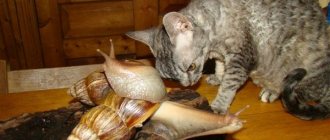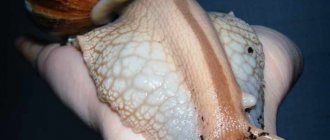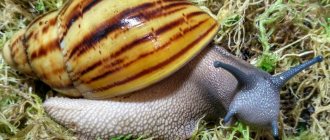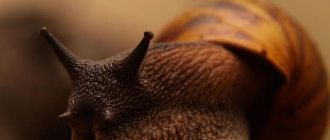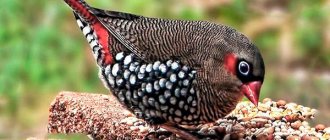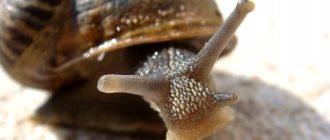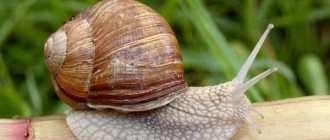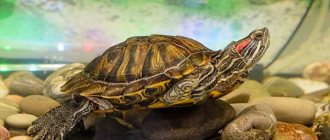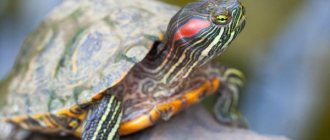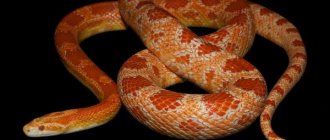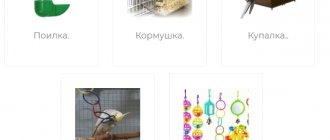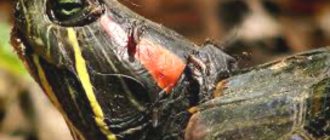Photo: UGC snails are unusual and incredibly interesting pets . From East African countries they spread throughout the world. It turns out that they not only grow up to 25 cm, but also lead an active lifestyle , are curious and are able to reach high speeds. Caring for them is as easy as shelling pears, just know the rules described in the article.
Keeping the Achatina snail (Terrarium)
A terrarium for Achatina can be made from a simple aquarium. The minimum size is 10 liters per snail. The larger the aquarium, the larger your snail will grow. The terrarium must have a lid, because snails can crawl out of it. It is advisable to arrange small holes in the lid for better gas exchange. As a last resort, you can simply lift the lid to create a small gap. You need to put bedding on the bottom of the aquarium. The bedding can be Begonia soil, or ideally a coconut substrate 5-7 cm thick. You can build a small bath with fresh water; Achatina loves to swim. The main thing is that the depth of the bath does not allow the snail to choke. In general, Achatina crawl well under water, but if it accidentally falls into the bath from above, a small snail can drown from fright. You also need to make sure that the bath does not turn over if the snail starts to burrow into the soil next to it, otherwise the water will spread out, which is not good.
The temperature and humidity required by Achatina are approximately the same as those in an ordinary city apartment. Soil moisture is determined empirically. If the snails sit on the walls of the terrarium all the time, it means there is too much water. If they prefer to be sealed (the evidence is hidden in the sink and closed with a lid), on the contrary, it is too dry. When the soil moisture is normal, snails crawl along its surface at night and often burrow into it during the day. To maintain humidity, it is enough to spray the soil and walls of the terrarium with a spray bottle twice a day.
To awaken a clogged snail, you can pour water over its mouth and carefully remove the cap, or simply place it in a terrarium with normal humidity. It is recommended to wash the terrarium at least once a week. The exception is a terrarium with a clutch of eggs, which must be cleaned without water so as not to change the humidity and not damage the clutch.
It is better to keep small snails without soil, covering them with cabbage or lettuce leaves, thereby increasing the chance of the snail finding food and making it easier to care for the terrarium.
Cleaning at Achatina
Cleaning in the terrarium can be divided into daily and general. Every morning it is advisable to remove leftover food and feces, wash bowls, and pour clean water. Once a week, loosen the soil; if it is dirty, replace it partially with new one. Also, the snail needs to be bathed at least 1-2 times a week.
General cleaning is carried out once every 2 months. The snails are transplanted into another container. The soil is completely removed, twigs, pieces of bark, and moss are replaced. The terrarium is thoroughly washed with soda and rinsed with water. Then new soil is poured in, clean bowls with food and water are placed. Decoration at your discretion.
Often during cleaning you can come across a snail clutch. If you plan to get offspring, you need to carefully transfer the eggs into a separate container where the babies will hatch. Otherwise, freeze them and feed them to your snails or throw them in the trash.
If cleaning is not done, Achatina begins to get sick, an unpleasant odor appears, and midges and other parasites appear. If not properly cared for, the snail may go into hibernation. If this happens, clean up, then wash the Achatina with warm water. Warm water will quickly wake up the clam. Don't forget to feed well.
Feeding the Achatina snail
It is better to feed as food is eaten and dried and remove any leftovers. Achatina eats vegetables, fruits and herbs, but in nature they do not refuse meat. Usually in captivity they are fed cabbage, carrots and cucumbers, but it is preferable to give them a more varied diet. This is necessary first of all so that at any moment you can switch to another available type of food. It is known that snails have certain food preferences, including many who prefer cucumbers and lettuce to other foods and, if they are fed only cucumbers from childhood, they often refuse to eat anything other than them, which can cause some inconvenience. Large snails can be given whole cores; they process food waste surprisingly quickly. Soft foods should be given only for a short period of time, otherwise they will flow and spread across the soil, causing it to become contaminated. It is generally not recommended to give soft foods to small snails. There was a case when snails buried themselves entirely in a banana and suffocated there. It is better to give very small newborn snails greens, grated carrots, and after a few days lettuce and an apple.
Can:
Fruits: apple, apricots, pineapple, avocado, bananas, pear, wild strawberry, strawberry, cherry, mango, papaya, plums, bunch of grapes, figs, watermelon, melon.
Vegetables: pumpkin, rutabaga, zucchini, broccoli, champignons, lettuce, cucumber, potatoes (boiled), carotel carrots, red peppers, celery, spinach, tomato, cabbage leaves.
Beans, peas (cooked or fresh), oatmeal.
Other: mushrooms, meadow plants/trees, nettles, daisy flowers, elder flowers, clover, dandelion, plantain, yarrow, sprouted oats, alfalfa, fruit tree blossoms (apple, apricot, peach...), bread (softened), milk (powdered) or natural), dairy/lactic acid products (without sugar, salt, spices), minced meat (minced meat, raw or boiled meat), egg (boiled), compound feed, meat and bone meal, peanuts (chopped), vegetable and meat baby food, gammarus.
It is important that the plants are not picked within the city, factories or enterprises, wastewater, or landfills. After you bring it home, rinse thoroughly in warm water!
You can’t (very important!):
Spicy, salty, sour, sweet, smoked, fried, pasta, potato eyes.
Useful tips from experts
Aquarists are convinced that nothing is easier than caring for Achatina - but only if a healthy snail has been purchased. To do this, you need to know how to choose the right tiger snails.
- You should not buy Achatina from your own hands; it is better to give preference to a pet store and observe the snail for some time: how it feeds, moves, how active it is.
- Before purchasing a terrarium, you should check the condition of the house, check how well it is ventilated, what its volume is, and whether the air is sufficiently humidified.
- Ideally, Achatina has a pedigree, which is noted in the registration documents.
- Achatina should be smooth, have a shell without damage, and it is better to buy when it reaches 2 - 2.5 months.
Remember that a properly selected and raised individual will bring significant benefits. For example, Achatina snails can be used in cosmetology. There are many recipes for masks that contain snail mucus. Beauty salons charge a lot of money for treating skin with Achatina snail. At home, such a procedure will not cost a penny.
If you have any questions about keeping giant Achatina snails at home, ask them in the comments
Effect of calcium on shellfish
Snails need calcium to build their shells. Calcium is a very common chemical element.
Lack of calcium in the snail's diet leads to curvature and deformation of the shell. The snail shell becomes softer due to lack of calcium; it is not protected from the environment. Since all internal organs are attached to the walls of the shell, any damage to it can lead to improper functioning of the organs or death. A mollusk that does not receive calcium from food, as a rule, lags behind in development: shell growth is disrupted or stops altogether, and puberty fails.
In order to prove how important calcium is for snails, I conducted an experiment.
Two groups of snails of the same age and species were taken and placed in the same conditions, but they were fed differently: some with food with added calcium, others with its complete absence.
Soon the snails of the second group stopped growing. It follows from this that calcium is indispensable for mollusks.
Snails kept in captivity receive calcium from sepia, eggshells, feed chalk, shell rock, gammarus, etc. For a more effective result, calcekashes are made. Calcekasha is a nutritious mixture made from various cereals with the addition of various sources of calcium; This product is served both dry and boiled.
How to care for Achatina
A container of water is placed in the terrarium so that they can bathe. The house with shellfish should be installed away from drafts, heating devices and direct sunlight.
How to bathe Achatina
From time to time, snails need a shower. To do this, place the pet in the palm of your hand and direct a stream of water from the tap onto it. The stream should not be strong, and the water must be warm. Such procedures are carried out no more than three minutes in duration. You can watch online how the Achatina snail bathes; the video can be found without any problems.
How to treat Achatina
Like all representatives of the fauna, Achatina can get sick. They are usually affected by parasites or fungi, but can be exposed to heat or chemicals and become injured. Treatment depends on the pet's illness. Molluscum is usually treated with food. If it is affected by fungus, it is carefully washed and the sink is cleaned, sometimes using a pesticide aerosol.
Breeding the Achatina snail (Reproduction of Achatina snails)
Achatina snails are hermaphrodites, that is, each individual has both male and female genital organs. In the absence of a partner, self-fertilization is possible, but it is quite rare.
The snail can store sperm for two years after mating, using it to fertilize maturing eggs. The number of eggs in a clutch is about 200 (in some cases up to 500); the snail can lay 5-6 clutches annually. The size of one egg is 4.5-5.5 mm, its shape resembles that of a chicken. Egg development is possible at temperatures from 22°C and lasts from several hours to 17 days.
What to feed Achatina
Snails are extremely unpretentious in food, they are vegetarians, and therefore you do not have to spend a lot and worry about food for your pet. Snails' favorite delicacies are lettuce, apples, and cucumbers. They happily eat bananas, carrots, cabbage leaves, watermelon and even tomatoes.
Allowed vegetables and fruits include beets and tangerines. Offer them to your pet; if the snail doesn’t like the treat, don’t insist, everyone has their own tastes.
Remember that snails should absolutely not be salted, fried or smoked. Do not offer Achatina junk food if you want to keep your pet healthy.
For a strong snail shell, it needs mineral nutrition. A mineral stone for birds, which can be purchased at any pet store, is suitable for this purpose. It is best to feed snails in the evening, because the main peak of Achatina activity occurs at night.
Treatment with Achatina at home
The medicinal properties of Achatina snails have been valued since the time of Hippocrates. Their meat has long been used to treat anemia and other diseases. And mucus was used for burns and non-healing wounds. The benefits of giant snails are such that farms began to be created to grow them after World War II. Now shellfish are successfully used to combat cellulite, varicose veins, and psoriasis.
Achatina against cellulite
Thanks to the effect of snail secretions, the skin becomes smooth and clean. This property is used to combat cellulite. If you treat problem areas of the body correctly and do not exceed the permissible number of procedures, then they will not cause any harm.
Dealing with orange peel with snail mucin is easy. Visible effect can be achieved within one month
It is important to perform anti-cellulite massage regularly, three times a week. He won't do any harm
During the procedures, snails are placed on a problem area, such as the stomach or thighs. The exposure continues for 15 minutes.
Achatina in the fight against varicose veins
The healing properties of massage help fight varicose veins. Before carrying out the procedure, thoroughly clean the areas that will be exposed. The snail is also washed under running water, after which it is placed on the body and allowed to move. After 10-15 minutes, the procedure is completed, and the remaining mucus is rubbed into the skin with massage movements for 15-20 minutes. The remains of the healing substance are washed off with water.
Treatment of psoriasis with snails
The beneficial effects of the substance secreted by snails on human skin are used to treat psoriasis. People who suffer from this disease are advised to keep these creatures as pets. While observing them, the nervous system relaxes and stressful conditions are alleviated. But the main benefit is the effect on rashes. Cosmetologists advise putting Achatina on them every day. Snail massage has the ability to relieve flaking and dryness and accelerate regenerative processes. For those who experience discomfort from touching snails, you can collect the substance they produce and rub it into the affected areas of the body.
Recommended soils
✅ Coconut substrate
It is ideal for keeping gastropods:
- available;
- does not get dirty;
- perfectly absorbs moisture;
- can be coarse, fine-grained;
- Coconut fibers are absolutely safe for gastropods and prevent the proliferation of parasites.
How to use coconut substrate:
- knead a third of the briquette;
- pour boiling water for 20–30 minutes;
- drain the water;
- dry;
- spread in a thick layer of 10 to 15 cm.
✅ Leaf litter
It is mixed with moss and laid on top of the base soil. Does not retain moisture and decomposes quickly. Collected in the fall, stored in a dry place (in a box).
✅ Forest cover moss
It can be easily collected in a park or forest. Before use, it is thoroughly washed from forest debris with settled water (without chlorine), scalded, and soaked in water for several hours. It is laid on top of the main bedding and washed every week. If the moss is green, there is enough moisture; as soon as it dries, you need to irrigate it with water.
✅ Sphagnum moss
Achatina is perfect for keeping Achatina, as it retains moisture, insects do not breed in it, and does not stain animals. Sold in flower shops.
✅ Earth
Natural soil should not contain fertilizers, garbage, or animal feces. Before use, it must be thoroughly washed and roasted in the oven. The cooled soil is mixed with 1 - 2 tablespoons of ground chalk.
✅ Neutralized peat
Advantages of peat:
- inexpensive;
- accessible;
- retains moisture well;
- does not cake.
Flaws:
- Peat only with a pH above 7 is suitable for mollusks, since the acid-base environment leads to burns of the body;
- may contain eggs of helminths and other parasites (before creating the litter, it must be fried for at least 15 minutes).
✅ Hazelnut shells
Crushed nut shells do not absorb moisture well, and water accumulates underneath and quickly stagnates. An unpleasant odor may attract insects. This type of bedding needs to be changed very often, but it does not stain the Achatina and is reliable protection in case of falls.
Benefits and harms
It is difficult to compare a snail as a pet with a kitten, puppy or guinea pig, but such pets have a number of undeniable advantages over any other animals:
- Does not require daily walks.
- You only need to feed once a day.
- They do not make sounds (except when eating).
- Interesting to watch.
- It can be trained by developing conditioned reflexes in mollusks.
- They can remain unattended for a long time, hibernating.
- High life expectancy up to 10 years (with proper care).
In addition to such advantages, the snail can also be useful to its owner for cosmetic and medical purposes. In order to protect their body from friction while moving, Achatina snails produce special mucus, which:
- promotes healing of the sole of the body in case of damage;
- participates in the process of repairing damage to the shell.
The properties of snail mucus are used by humans in:
- economic activity;
- folk and alternative medicine;
- cosmetology.
After lengthy scientific research, the composition of snail mucus has been carefully studied. It includes the following components:
As a result of research, it has been established that the mucus produced by snails contains the following components:
- Vitamins of groups A, S.E.
- Collagen.
- Amino acids.
- Elastin.
- Antibacterial ingredients.
- Allatonin.
The properties of snail mucus include:
- assistance in the treatment of bronchitis and other diseases of the upper respiratory tract;
- the formation of a protective cover (film) on human skin that allows oxygen to pass through and prevents moisture loss;
- hypoallergenic;
- accelerating the process of cellular regeneration;
- analgesic effect.
In cosmetology, snail mucin Achatina is used for:
- combating wrinkles around the eyes and other age-related skin changes;
- eliminating facial wrinkles;
- skin rejuvenation;
- cleansing of dead cells (peeling);
- restoring the water balance of the skin;
- skin regeneration, including after aggressive cosmetic procedures;
- lightening the skin and getting rid of pigmentation;
- treatment of scars and scars.
Achatina snails and their mucus are often used in alternative medicine for:
- treatment of postoperative scars;
- speedy healing of wounds and burns;
- eliminating cellulite and cleansing the body of accumulated heavy fats, which cannot be eliminated by traditional methods and physical exercises;
- relieving muscle spasms and tension without additional pain;
- therapy of inflammatory processes that provoke various diseases and even infertility;
- treatment of stress and diseases associated with intense mental and physical stress;
- therapy of vegetative-vascular dystonia;
- restoration of the nervous system;
- treatment of varicose veins.
Achatina snails are absolutely safe for humans, but in some cases they can cause harm:
- Mucus may contain dangerous bacteria and pathogenic microorganisms, which, if they get into open wounds, can lead to dangerous diseases.
- Despite the hypoallergenic nature of snail mucus, in some cases its use causes undesirable reactions on the skin, including angioedema.
- Eating shellfish meat can also cause allergies.
Considering that Achatina are purchased mainly from breeders and bred in captivity, they are not carriers of dangerous tropical diseases.
The main rules for communicating with a snail
There are several rules that must be strictly observed when communicating with Achatina.
- The first rule: communication with Achatina must be started with clean, wet hands. Hands must be washed with soap and rinsed thoroughly so that no soap marks remain on your hands. Also, there should be no traces of cream, aromatic oils, etc. on your hands.
- The second rule: do not touch or pull the sink with your hands. Achatina sticks to the walls of the home very tightly. If you try to tear it off by taking it by the shell, the snail may remain on the wall, and its shell in your hands. This is practically death for the animal. Therefore, before picking up your pet, you need to spray it with a little water, and use a wet finger to touch its face and the front of its leg. Achatina will crawl onto a wet hand and unstick the rest of the leg from the wall of the aquarium. Also, you should not touch the growth, as it can easily be damaged. Then the further formation of the shell will occur with disturbances, it will become covered with scars.
- Third rule: you cannot forcibly pull Achatina out of the shell, as you can damage not only its house, but also Achatina’s body.
- Fourth rule: children should not be allowed to play with snails without supervision.
- Fifth rule: after interacting with your pet, be sure to wash your hands with soap. All gastropods are carriers of parasites. You can get infected through dirty hands. This is especially true for children.
Popular types of Achatina
The most common species and the easiest to care for is the Achatina fulica species. The shell of these snails is distinguished by its variegated color, which changes its color depending on the diet. The snail's body may be brownish or brown in color with pronounced tubercles on the skin of the mollusk. Achatina fulica is slow and melancholy; she likes to relax a lot in a cozy corner of the terrarium.
Another common type of snail for home keeping is the reticulata. Its representatives are distinguished by a peculiar pattern on their shells in the form of dots or stripes. Body color is dark brown or black. Snails of this species are more sociable, they are mobile and curious, often raising their heads, wanting to examine what is happening.
How to choose
The popularity of snails is due to their unusual color and impressive size. There are about 100 species of Achatina in nature, among them the most popular for home keeping and breeding are:
- Fulica - a prolific and unpretentious variety of mollusk. It is distinguished by its unsociable disposition and slowness.
- Immaculata- looks like a fulica. Attracts with its beautiful appearance.
- Reticulata - characterized by activity, intelligence, contact. White mollusks, albino reticulata, are considered valuable and beautiful.
- Gigantic - grow to an impressive size of up to 37 centimeters, weighing 450 grams.
- Lemon - the name is due to the presence of a light yellow shell. Individuals are viviparous and are small in size.
The description of the structure of different breeds of snails, the rules for their maintenance and care are identical. When purchasing, take into account the size of the mollusk and the color of the shell. What the color scheme of Achatina shells looks like can be seen in the photo - from light to dark brown with patterns and stripes, the body - from milky to brown tones.
Tips for choosing a shellfish:
- It is not recommended to purchase Achatina from your own hands; it is better to buy it at a pet store, since African snails come with a pedigree registration document. Professional breeders do not seek to sell individuals in large quantities, and also do not sell egg laying.
- It is advisable to pay attention to the conditions of keeping mollusks: terrarium, temperature conditions, diet.
- It is not recommended to take a snail less than 2 months old. You can recognize it by its curls: the more there are, the older the Achatina. An adult individual has 7-9 turns on its shell, twisted counterclockwise.
- It is important to inspect the shell of the mollusk to make sure there are no scratches, cracks, or chips.
The price of snails is low, ranging from 50 to 8,000 rubles; reticulum often costs more. The average cost of a shellfish is 300-1000 rubles. Maintenance and care also do not require significant material and time costs.
How often should you water clams?
Water is the source of life for African snails. It helps maintain body temperature, digest vitamins and minerals, remove toxins from the body, and produce protective mucus.
It is important to give the Achatina snails the opportunity to quench their thirst every time after feeding. For these purposes, you can purchase a spray bottle: mollusks love to drink, licking drops of water from the walls of the terrarium. To avoid dehydration of Achatina, you should regularly moisten the soil in the terrarium and keep a saucer of clean water at room temperature.
Shellfish need water to live.
It is important to choose a container with low sides. Otherwise, the clam may choke. Do not use regular tap water. Its high chlorine content is dangerous for snails. Boiled, filtered, bottled water is suitable for Achatina.
Prohibited soils
❌ Sawdust
This type of bedding is not recommended by fish breeders, as sawdust (splinters) can injure the animal’s delicate body and esophagus.
❌ Sand
Not recommended due to the abrasive properties of sand. It can injure both the leg and Achatina’s house, get hidden under the sink, and cause discomfort. Once in the esophagus, it can clog the intestines and kill the mollusk.
❌ Pebbles
Small stones and pebbles are absolutely not suitable for lining the bottom of the terrarium. Achatina cannot burrow into it; they can be injured on hard stones if they accidentally fall.
❌ Clay
Pure clay is absolutely not suitable for a snail terrarium. It gets saturated with water, swells, gets dirty, and gets compressed. Once in the snail's stomach, it literally cements everything around it.
Sources of calcium in the snail's diet
Calcium is the main element for the construction of a strong and beautiful Achatina shell. An accessible source of useful minerals are calcium supplements:
- Chalk is used in the form of a special feed powder made from a natural mineral, and not those multi-colored crayons that children use to draw on the asphalt. Any hint of chemistry in the treat will make the snail completely indifferent to it.
Feeding chalk can be given to snails for the formation and growth of a strong shell
- The shells of raw eggs are ground into powder. This is easy to do with a regular rolling pin. The shells should first be rinsed thoroughly with warm water and dried thoroughly. It has been proven that the shells of boiled eggs are much less digestible by snails.
- Sepia is the cuttlefish shell loved by snails. Natural is distinguished by its pure white color; any other shades indicate the presence of harmful dyes in the composition of the fertilizer. Before use, it is soaked for several hours to remove the salt in it.
- Shell rock - buy ready-made powder, or grind the shells in a coffee grinder.
Supplements can be given to snails individually, or they can also be mixed and used all at once as part of healthy calcium mixtures.
Snail diseases and shell injuries
If the rules of care and maintenance are followed, Achatina is rarely susceptible to disease. External symptoms will help determine that your pet is sick:
- apathy, lethargy;
- refusal to eat;
- blockage of the entrance to the shell;
- excessively copious or thick mucus;
- pronounced separation of the shell;
- if Achatina is in pain or scared, it is capable of emitting whistling-hissing screams that cannot be ignored.
A terrible sign is considered to be the snail falling out of its shell, resulting in its rapid death. How Achatina die depends on the cause of death. A severely weakened mollusk is identified by the absence of reflexes - when touched, it instinctively does not pull its head and body into the shell. If the shell is sealed for a long time and the pet cannot be awakened, this may also indicate that it is dead. The main sign of death is that a dead snail emits an unpleasant rotten egg smell. However, if it dies during prolonged hibernation, it may be absent, since the body becomes liquid.
The causes of Achatina diseases are:
- hypothermia or overheating of the pet;
- cramped terrarium, dry or excessively wet filler;
- infrequent cleaning of the aquarium, lack of hygienic water procedures for the snail;
- accumulation of food debris, excrement, mold in Achatina’s home;
- consumption of “harmful” foods, low-calorie and monotonous diet with insufficient amounts of calcium and protein;
- lack of ventilation, poor quality filler.
As a result of the influence of the listed factors, exposure of the snail to carcinogens, infections, fungi, parasites, etc., its health condition worsens. To treat shellfish and eliminate pathogenic microorganisms, iodine, the medicine “Mikoseptin”, and ointment with propolis are used. If you follow the correct diet, measures for cleaning the terrarium and other conditions for keeping your pet, the risk of disease is minimized.
A common problem in Achatina is the violation of the integrity of the shell. The snail may fall if moved or handled carelessly. Minor damage is lubricated with an antiseptic. If the shell is broken or cracked, breeders repair the defect using epoxy glue. If traumatized, the snail must be placed separately from other individuals, since they like to rub their shells.
Attention! It is important to provide a diet rich in calcium. This will speed up the wound healing process in the pet’s body.
To avoid injury due to careless handling, the owner must follow a number of rules:
- pick up the pet with clean and wet hands and do not use any chemicals on them: soap, cream, etc.;
- You should not forcibly tear the mollusk from the walls of the terrarium or squeeze it - this can damage the shell and internal organs;
- take the pet carefully under the sole, and not by the shell.
